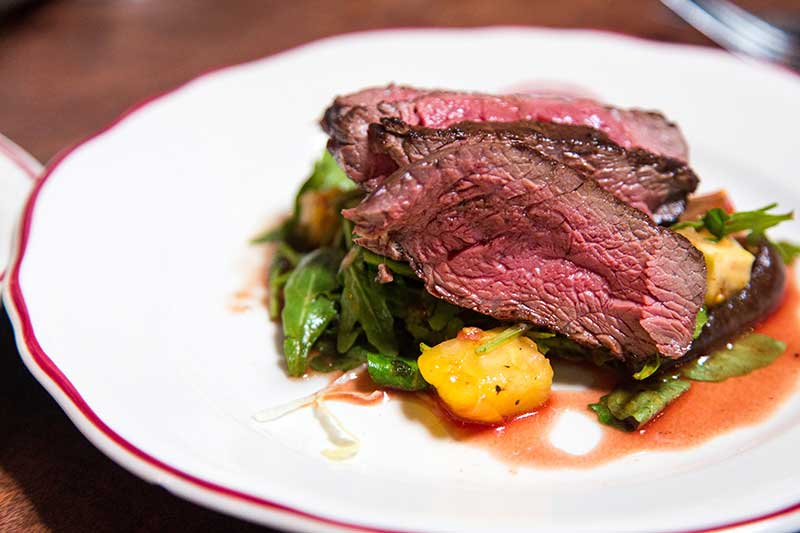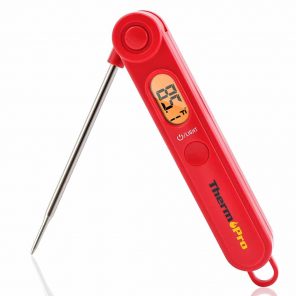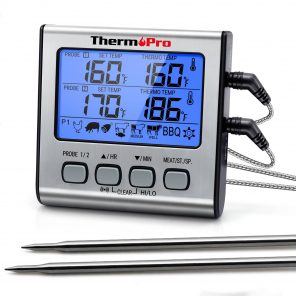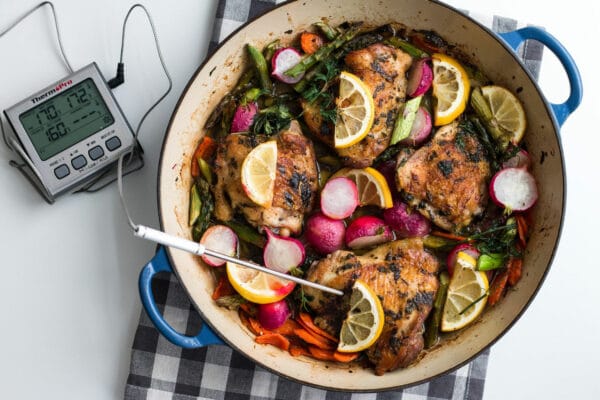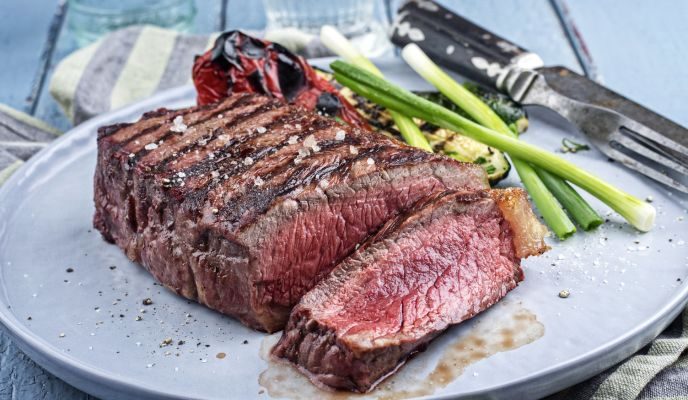The customer service team is always listening, taking notes, and quantifying complaints to ensure our products are continually improved. Due to selling directly to you, the customer, via Amazon, we can use product reviews to help us improve our existing products or help further development of new products.
Table of Contents
The touch test for meat doneness, a traditional cooking tool used by grilling experts across the world, isn’t quite as accurate as you might think. Many cooks look at the meat’s color or use the finger test to check the doneness of meat, but these methods don’t actually tell you if something is safe to consume. The only real way to check meat for doneness is to use a meat thermometer for an accurate and temperature-specific reading.
With that said, a thorough knowledge of meat doneness is an asset to any grill cook. To find the perfect degree of doneness, you need to know what texture, color, and temperature to look for in that burger, cutlet, or steak.
Texture and Meat Doneness
Cooking meat to the right degree of doneness is all about texture. Rare meat is soft and smooth, medium has a bit more bite to it, and well done is so cooked it’s almost contentious.
The touch test is no replacement for a thermometer, but it’s still a good way to know if your steak is almost done.
What Happens to Meat When It Cooks
Like any food, a piece of meat can be reduced to its cellular structure. Meat is made from muscle. A muscle is composed of protein fibers surrounded by collagen sheaths. Moisture surrounds these fibers and creates the “juice” in a good steak; a piece of meat can be as much as 70% moisture. Fat may also be marbled throughout the cut.
When a piece of meat hits the surface of a grill, the proteins start to unravel. This is called denaturing. The collagen sheaths deteriorate, the proteins break down, and moisture is pushed out of the steak. This is why a piece of meat seems to “shrivel” if it is cooked quickly.
The hotter the meat gets, the more the proteins break down and the tougher the meat becomes. Great grilling requires you to achieve the perfect level of breakdown without losing too much moisture.
A raw piece of meat feels like all water. An extremely well-done piece of meat is so dry it’s almost crisp. The entire range of textures between the two represents a myriad of tastes and cooking styles.
Soft, Tough, and Crispy
Use your finger or a utensil to check the doneness of meat. Poke the meat gently so as not to damage the surface.
Pay attention to the way the meat gives when pressure is applied. Rare meat will feel squishy. Well-done meat will be tough. Crispy meat is out of moisture entirely. Different cooking methods will deliver different results.
How to Use the Palm Test
Hold your hand loose and relaxed. With your other finger, feel the fleshy area on your palm beneath your thumb. This is what raw, completely uncooked meat feels like. As you flex your hand, you can recreate the various stages of doneness with muscle tension.
- Touch your thumb and your first finger. This is the feeling of rare meat.
- Touch your second finger to recreate medium done meat.
- Touch your thumb to your ring finger for medium well done meat.
- Touch your pinky to feel the texture of well done meat.
This method is not completely accurate; some people have more tension in their hands. Still, you can use this as a way to learn meat doneness without burning your fingers.
Variations on this method just involve checking the tension of a different muscle. You can clench your fist, feel the tautness of your cheek, or even use your bicep; all you’re doing is comparing the different levels of muscle tension to the firmness of a steak.
Can You Check Meat Doneness by Color?
The fantasy of grilling is that you’ll be able to tell the doneness of a steak just by looking at it. You can hear the sizzle, see the edges crisping, and smell the perfectly cooked juices – so it’s done, right?
Not necessarily. Meat needs to reach a minimum internal temperature to meet food safety standards. For whole cuts, this temperature is 145 degrees; for ground meats, this temperature goes up to 160 degrees. The challenge of rare cooking is meeting these guidelines without overdoing the steak.
From Pink to Done
There is some correlation between color and doneness. In general, a raw cut of meat is extremely pink or red. Cooking will darken this color as the meat loses moisture and changes in structure.
Beef tends to go from red to pink to brown as it reaches different stages of doneness. Poultry and fish tend to go from pink to white, although shrimp stay pink on the outside when they are done.
The juices of a piece of meat also change in color. White meats have clear juices when cooked through. Red meats give off darker juice in relation to the degree of doneness.
Why Color Isn’t Accurate
The problem is that, while cooking does change the appearance of meat, these changes are not predictable. Factors like type, cut, age, and preparation will all impact the color of any kind of meat.
To truly relate color to doneness, you need to check the inside color of the meat. Unfortunately, a cut through the center of that perfect burger patty will completely ruin it. Technically, cutting into any piece of meat before it’s done will release the juices and result in a dryer, tougher meal.
A food thermometer is the only way to know when a piece of meat is done. You can use your eyes and your other senses to make very accurate guesses, but only a temperature check can guarantee both flavor and safety.
How to Use a Thermometer to Check Meat for Doneness
Whole cuts of meat like beef, venison, and pork need to reach an internal temperature of 145 degrees. Ground meats like beef or sausage need to reach an internal temperature of 160 degrees. No matter how it has been prepared, poultry always needs to reach a minimum temperature of 165 degrees.
Once a piece of meat has reached ideal temperature, the USDA recommends that you remove it from the heat source and let it rest for three minutes. This length of time guarantees that the entire cut has been fully cooked.
Every grill cook should invest in a high-quality meat thermometer. A simple, single-prong thermometer will work for most cooking situations. Many digital thermometers come with more features and promise more accuracy. ThermoPro Food Thermometers come in both standard and professional varieties; choose one that suits your style of grilling.
-
ThermoPro TP-17 Dual Probe Digital Meat Cooking Thermometer
$31.99 $31.99Rated 4.96 out of 5Add to cart
Calibrating Your Thermometer
Thermometers measure accurately to themselves. To make sure the display is reading correctly, you need to calibrate your thermometer.
The easiest way to do this is with a cup of ice water. Fill the cup with ice, add water, and wait a minute for the water to chill. Place the thermometer against the ice and check the temperature.
If your thermometer reads 32 degrees, it is perfectly calibrated. If it doesn’t, take note of the difference and use that to make accurate measurements. A thermometer that reads 35 degrees when touching ice is exactly 3 degrees off calibration. Some thermometers let you adjust their readout after you calibrate.
Checking Meat for Doneness
Use your thermometer on the thickest part of the meat. This part will always take longer to cook; if it’s done, the rest is done too. Wait a full 45 seconds or until the display stops changing to see the accurate temperature. Pockets of hot air can pass through a steak or a chicken breast and indicate a higher temperature, but these pockets only last for a moment.
A thermometer creates a hole in a piece of steak. This is unavoidable, but you can make plans to minimize the damage. First, use your eyes or the finger test to accurately guess when the meat is almost done. Next, insert the thermometer from the side or into an already damaged part of the cut. Make sure the tip of the device makes it to the center.
Cooking with Temperature as a Guide
Take note of the correlation between meat temperature and flavor. A steak at 142 degrees and a steak at 151 degrees will have different textures and tastes. Use your thermometer to achieve your ideal doneness again and again.
Rare and medium rare steaks may be cooked to 130 or 135 degrees. Do not attempt this with other kinds of meat, and understand that eating rare meat may pose an inherent risk.
Steaks meant to be rare should be kept below 40 degrees and cooked immediately after they’re removed from the fridge. Use prudence and trust your instincts. Don’t cook rare steaks from a barbecue ice box; they may have warmed up over the day.
As a piece of meat cooks, it loses moisture, darkens in color, and gains a tougher texture. Balancing these factors is a matter of artistry. You want to maintain moisture, control texture, and serve something that is safe to eat. If you aren’t sure about a piece of meat, cook it to 165 degrees; it’s always better to be safe when it comes to food safety.
Your food thermometer is your most accurate indicator of meat doneness. Learn to use it well and you’ll produce perfect steaks every time.

